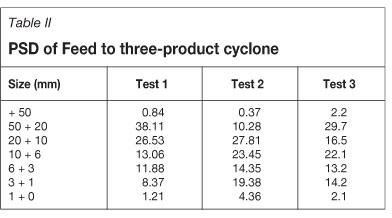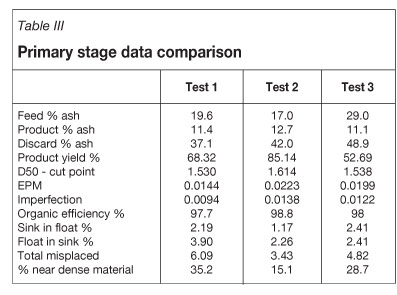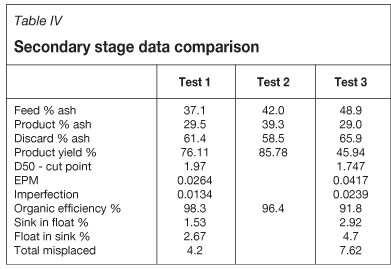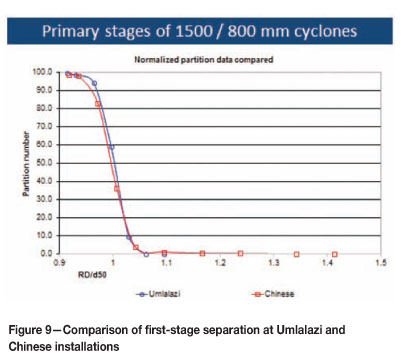Serviços Personalizados
Artigo
Indicadores
Links relacionados
-
 Citado por Google
Citado por Google -
 Similares em Google
Similares em Google
Compartilhar
Journal of the Southern African Institute of Mining and Metallurgy
versão On-line ISSN 2411-9717
versão impressa ISSN 2225-6253
J. S. Afr. Inst. Min. Metall. vol.113 no.11 Johannesburg Nov. 2013
The three-product cyclone: adding value to South African coal processing
J. Jacobs; G.J. de Korte
Enprotec, Middleburg, Mpumalanga, South Africa
ABSTRACT
The three-product cyclone was originally developed in Russia and is now extensively used in China. The cyclone has recently entered the South African coal industry, and with the obvious advantages that this item of process equipment offers our ever-evolving industry it is safe to assume that it will add value to dense medium circuits in South Africa. Some of the possible applications include:
> Producing multiple products using a single dense medium circuit. These can typically be a primary product with calorific value of 27.50 MJ/kg and a secondary (middling) product with a calorific value of 22 MJ/kg
> High-density separation with a low circulating medium density.
Anglo Thermal Coal and Exxaro have pioneered the use of these units at Umlalazi and New Clydesdale respectively. Extensive test work has been performed at Umlalazi to determine the efficiency of the unit and to determine how it compares with the conventional DSM (Dutch School of Mines) cyclone. Some people in the coal industry were initially sceptical and expected the performance of the three-product cyclone to be inferior to that of the conventional dense medium cyclone. The results of the test work have, however, shown that the efficiency of the unit is comparable to that of the cyclones currently employed. A valid concern expressed is the control over the cut-point density of the second stage separation, and work is on-going to find the optimal way to control the secondary separation density. Theoretically, the secondary separation density can be manipulated by changing the orifices of the unit, especially the spigot of the secondary stage. This remains to be proven, and a series of tests is currently being planned.
Whatever the result of these tests may be, the three-product cyclone definitely has a place in the South African coal processing industry as it offers a low OPEX and CAPEX solution for producing multiple products from a single circuit, as well as the ability to operate at very high separation densities, while making use of low-density circulating medium.
Keywords: dense medium separation, DSM, three-product cyclone, coal processing.
Introduction
During a visit to China in 2009, Coaltech was made aware of the Chinese three-product cyclone and realized that the cyclone could gainfully be employed by coal preparation plants in South Africa where a primary as well as a secondary product is produced.
Two Coaltech members, Anglo Thermal Coal and Exxaro Coal, agreed to evaluate the three-product cyclone on their operations and subsequently these units were imported from China. The unit ordered by Anglo Thermal Coal through process technology company ENPROTEC arrived first and was installed at Umlalazi Plant, a division of Landau Colliery. Umlalazi Plant was constructed in 2008 and was designed on a modular basis to treat 200 t/h of ROM.
Umlalazi proved to be the ideal test site for the three-product cyclone, as normal operation consisted of producing a high-grade (27.5 MJ/kg) product from the open pit no. 4 seam as a primary product. The discard from this process was then stockpiled and later retreated in the same facility to produce a low-grade domestic product (21-22 MJ/kg). Although a marketable secondary product was produced it came at a high operating cost when taking its value into consideration.
The operation at Umlalazi prior to and after the installation of the three-product cyclone is shown in Figures 1 and 2 respectively.


The three-product cyclone at Umlalazi was commissioned during December 2011, and with the exception of requiring minor modifications has exceeded all expectations. The unit has subsequently become part of the everyday operation.
The rated capacity of the installed 850/600 unit is 170 t/h according to the original equipment manufacturer (OEM) specification, which proved to be the perfect fit at Umlalazi -assuming 15% of feed to plant is the -1 mm fraction reporting to the fines circuit. As recommended, a feed pressure to the primary cyclone of 130 kPa should be maintained, which results in a secondary feed pressure of 95 kPa.
Three comprehensive assessments of the three-product cyclone operation at Umlalazi have been done over the last 18 months - all proving that the efficiency of the unit is not questionable. The correct application of these units in South African coal preparation plants can be extremely beneficial in an industry where multiple product operations are more common due to the high demand locally and abroad for lower value thermal coal.
General information about the three-product cyclone
Although the three-product cyclone concept was originally developed in Russia, very little literature exists from Russian sources.
The three-product cyclone consists of a cylindrical dense medium vessel, similar to a Larcoderms, with a conventional dense medium cyclone attached to the rejects outlet of the primary unit. The cyclones can be pump fed or gravity fed -Figures 3 and 4 show a gravity-fed and pump-fed cyclone respectively.


Table I represents the various available size units, with capacities and operating conditions required.
History of the three-product cyclone in China
In late 1970s, coal preparation industry experts came to realize that heavy medium coal preparation, especially heavy medium cyclones, will be a leading trend as a result of high efficiency, simple structure, and ease of automation. However, in China, which produces mainly refractory coal, the traditional heavy medium coal preparation processes, including desliming, classification, high and low density media, a recovery system, and two separation stages for three products, were far too complicated. Thus, it becomes necessary for China to simplify the processes while maintaining separation efficiency.
In 1979, China Coal Research Institute established a research team to develop a three-product HM cyclone with pressurized feeding.
In 1984 and 1989, the 500/350 and 710/500 three-product cyclones with pressurized feed were successively developed and applied in the Liaoning Benxi Cai Tun and Heilongjia Jixi coal preparation plants.
In 1992, China's first cylindrical + cylindrical three-product HM cyclone (the 700/500) with non-pressurized feeding went through a successful test in Heilong'iang Jixi Didao coal preparation plant and was patented.
In 1995, a cylindrical + cylindrical-conical three-product HM cyclone (the 700/500 A) with non-pressurized feeding was successfully tested in Sichuan Changshou Xishan coal preparation plant, thus establishing a fundamental structure for the three-product HM cyclone with non-pressurized feed.
In 1999, a large 1200/850 three-product HM cyclone with non-pressurized feed was put into service in Guizhou Panjiang Laowuji coal preparation plant. It helped to promote heavy medium coal preparation technology, but some problems were encountered. For example, the second stage separation density was not easily adjustable and the cyclone was not very wear-resistant.
In 2000, an improved 1200/850A cyclone replaced the 1200/850 unit in the Laowuji Plant and proved to have a long service life.
In 2003, a 1300/920A unit was successfully installed in the Guizhou Panjiang Huoshaopu coal preparation plant and the test results were positive.
In March 2004, as a core item of equipment in a national high-tech industrialization demonstration project, a 1400/1000A unit was put into service, proving that the large three-product HM cyclone had become a mature technology.
Since 2000, China has seen a boom in the construction of coal preparation plants, and by March 2006 the combined coal preparation plant capacity exceeded 200 Mt/a. The three-product cyclone coal preparation technology is now the preferred option in modern coal preparation plants (Figures 5 and 6).


Performance tests
The data presented in this paper summarizes the results obtained during three performance assessments conducted at Umlalazi.
Summary of tests
Test 1-3 February 2012
An efficiency test was carried out to evaluate the performance of the three-product cyclone. The feed material to the cyclone was the typical no. 4 seam select, and it was decided beforehand the test would be conducted over a short space of time to eliminate any process fluctuations. Samples were taken of the feed, primary product, secondary product, and final discard. A minimum of 30 increments (sample scoops) were taken from each of the sample points. A sample of the circulating medium was also taken.
Sampling and analysis was conducted by Noko Analytcial Services in Emalahleni. The samples were screened at Noko to provide the following size fractions, which were analysed separately.
- 50 x 20 mm
- 20 x 10 mm
- 10 x 1 mm
- -1 mm
Test 2 - October 2012
The main objective of this second efficiency test was to build up a database of information for comparative purposes.
Sampling was done on a similar basis as in the first test. Noko Analytical Services was again responsible for sampling and analyses.
Test 3 - April 2013
The objective this test was to evaluate the suitability of the three-product cyclone for processing the raw coal from Kromdraai (1 seam and 2 seam), in order to produce a prime product and a thermal coal using a single-medium circuit. The test was conducted at Umlalazi coal processing plant with approximately 200 t of Kromdraai raw coal, which was transported to Umlalazi for the test.
Samples were taken and analysed by Noko Analytcial Services. The samples were screened at Noko to provide the following size fractions which were analysed separately.
- 50 x 20 mm
- 20 x 10 mm
- 10 x 1 mm
- -1 mm
Analytical methodology
It is important to understand that determination of the efficiency of the three-product cyclone is complicated by the fact that the sinks from the primary cyclone (which is also the feed to the secondary) cannot be sampled. This means that neither the primary nor the secondary stage partition curve can be computed directly. The following iterative procedure was therefore used to obtain the partition data for the two cyclones:
- A value is assumed for the ash content of the primary cyclone sinks (which is also the secondary feed)
- Using the assumed ash content and the washability data of the secondary product and sinks, the reconstituted washability of the feed to the secondary cyclone can be computed
- Once the washability of the primary sinks is known, the reconstituted primary feed washability can be computed
- The reconstituted feed washability is then compared to the sampled feed washability and if the two washabilities differ, the process is repeated with a slightly different value for the primary sinks ash
- This is repeated until the best possible agreement between the sampled and reconstituted feed washabilities is obtained.
Test results
The size analyses of the feed to the three-product cyclone are shown in Table II.

For the purpose of the comparison, only the data reflecting the 50 mm x 0.5 mm size fraction is considered here and not individual size ranges, as only test 1 and test 3 were done per individual size range. The individual size range data is available upon request.
The data from the primary and secondary stages are shown in Tables III and IV respectively.


The normalized partition curves of the first-stage and second-stage cyclones obtained during all three tests are shown in Figures 7 and 8 respectively. Owing to the higher than expected secondary cut-point, not all the secondary stage partition curves could be completed.


Discussion
The three-product cyclone performed extremely well during all three determinations, especially on the primary separation. The separation efficiency in the primary stage compares as follows:
- Test 1: EPM = 0.0144, organic efficiency = 97.7%
- Test 2: EPM = 0.0223, organic efficiency = 98.8%
- Test 3: EPM = 0.0199, organic efficiency = 98.0%
All of these are excellent results, especially considering the very high near-dense material in test 1 and test 3. One of the important factors to consider when opting for the three-product cyclone is whether or not primary separation and subsequently primary yield will be adversely affected. The primary product in a coal processing plant is the high-value product - thus any losses in the primary stage would have a serious impact on the operation. The results obtained consistently show that the primary stage of the three-product cyclone is very efficient.
The separation efficiency of the secondary stage of the cyclone was also very good, and compares as follows:
- Test 1: EPM = 0.0264, organic efficiency = 98.3%
- Test 2: EPM and organic efficiency could not be determined
- Test 3: EPM = 0.0417, organic efficiency = 91.8%
In test 2 the performance parameters of the second stage of the three-product cyclone could not be determined due to the high cut-point density of the second stage and the fact that the float/sinks analysis was carried out only up to a density of 2.10. The secondary stage offers a very effective high-density separation and the efficiency is at least as good as that of conventional cyclones. It is also worth noting that such a high secondary cut-point can be achieved by using a circulating medium with a density of about 1.4-1.5.
Conclusion
The three-product cyclone has proven itself as an effective means to produce multiple products utilizing a single dense medium stream. The fact that it performed well with various ROM sources (1, 2, and 4 seams) is very impressive. Figure 9 compares the performance of the primary stage of these units in China with that of the unit installed in South Africa at Umlalazi. It clearly indicates the excellent results achieved at Umlalazi are common for these units.

There are factors that still need optimization, the most important being controlling the secondary cut-point density.
This has, however, not prevented two of the largest export mines in the Witbank coalfields from installing these units, simply for the huge benefits that the three-product cyclone offers. The new installations will make use of variable-speed feed pumps and adjustable vortex finders on the secondary cyclone - this will afford the opportunity to measure the impact of these variables on secondary cut-point adjustment.
In view of all the advantages that the three-product cyclone offers, it is certainly a technology that needs to be explored and applied in South Africa's continually evolving coal industry, where reduced OPEX and CAPEX, operational efficiency, and the production of multiple saleable products are becoming more important.
Acknowledgements
A special word of thanks to Johan de Korte for the data and the guidance provided. Also to Landau Colliery for pioneering this technology and allowing the authors to use the data from the performance tests.
Bibliography
De Korte, G.J. Report on the performance of the three product cyclone at Umlalazi Colliery in February 2012. Report CSIR/CMI/NMM/ER/2012/004/B. [ Links ]
De Korte, G.J. Report on the performance of the three product cyclone at Umlalazi Colliery in October 2012. Report CSIR/CMI/NMM/ER/2012/037/B. [ Links ]
De Korte, G.J. Report on the performance of the three product cyclone at Umlalazi Colliery in April 2013. Report CSIR/CMI/NMM/ER/2013/0008/B. [ Links ]
De Korte, G.J. A review on dense medium cyclone performance. [ Links ]
Zhao Shuyan. President of Tangshan Guohua Technology Co., Ltd ♦ [ Links ]
Paper received Sep. 2013
Revised paper received Oct. 2013
© The Southern African Institute of Mining and Metallurgy, 2013. ISSN 2225-6253.














